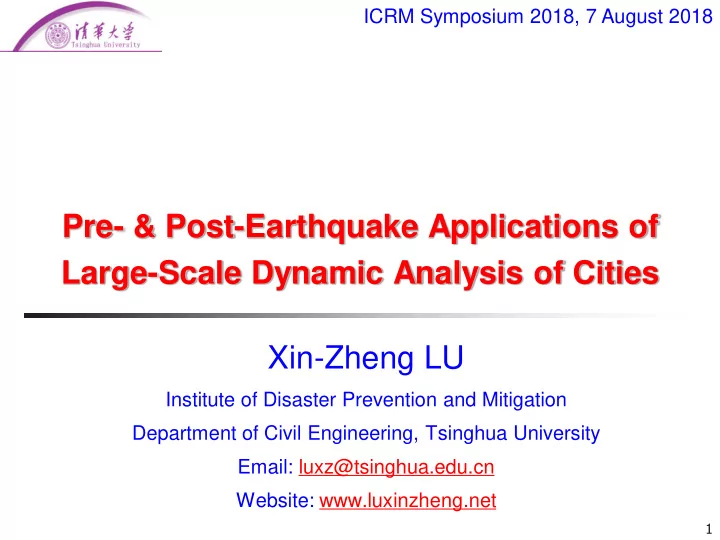

ICRM Symposium 2018, 7 August 2018 Pre- & Post-Earthquake Applications of Large-Scale Dynamic Analysis of Cities Xin-Zheng LU Institute of Disaster Prevention and Mitigation Department of Civil Engineering, Tsinghua University Email: luxz@tsinghua.edu.cn Website: www.luxinzheng.net 1
What? ◼ What is Large-Scale Dynamic Analysis of Cities? Input Structural dynamics Building Earthquake ground motion Seismic damage Input Structural dynamics City 2
How? ◼ How to do Dynamic Analysis of Cities? Structural dynamic models (Physics driven model) The ground motion Structural dynamic Dynamic (recorded or simulated) models (multi-scale response models) Advantage • Strictly following the fundamental of structural dynamics • Accurately represent the features of individual buildings • Accurately represent the characteristics of earthquakes 3
Typical example ◼ Beijing CBD under M8.0 Sanhe-Pinggu Earthquake (1679) Beijing CBD 4
Typical example ◼ Beijing CBD under M8 Sanhe-Pinggu Earthquake (1679) CCTV Tower Z-15 Tower World Trade Center-3 5
Typical example ◼ Beijing CBD under M8 Sanhe-Pinggu Earthquake (1679) 6
Typical example ◼ Beijing CBD under M8 Sanhe-Pinggu Earthquake (1679) 7
Why? Pre-EQ Conventional method EQ magnitude Significant Uncertainty Urban planning, Disaster preparation Building info. EQ Intensity Significant Post-EQ Uncertainty Uncertainty Fragility curve Significant Uncertainty Loss Emergency response 8
Why? Significant uncertainty: Conventional method Magnitude vs. Intensity = + − + EQ I a a M a ln( R R ) 0 1 2 1 0 magnitude Significant Intensity magnitude distance Uncertainty EQ Intensity Significant Uncertainty 9
Why? Significant uncertainty: Conventional method Intensity measure vs. Structural response EQ Structural seismic response ( ln( DM i ), ln( IM i ) ) demand measure ln( DM ) magnitude Significant (ln( DM ) = ln( a )+ b ln( IM ) Uncertainty Correlation coefficient r b n − b b 2 Building info. EQ Intensity (ln( DM ) ln( aIM )) i i b = = i 1 − n 2 Significant Uncertainty Ground motion intensity measure ln ( IM ) Uncertainty 1 PGA S a ( T 1 ) Correlation coefficient r 0.8 Fragility curve 0.6 0.4 0.2 Maximum drift 0 10 0 2 4 6 8 10 12 T 1 (s)
Significant uncertainty of intensity measure 2011 Japan, Tohoku EQ 3.00 2.00 1.00 0.00 a / g -1.00 2.9g! -2.00 -3.00 -4.00 0.00 20.00 40.00 60.00 80.00 100.00 120.00 140.00 t /s Limited damage 11
Why? ATC-13 Conventional method EQ magnitude Significant Uncertainty Building info. EQ Intensity Epicenter in recent 40 years Significant Uncertainty Uncertainty Fragility curve Significant Uncertainty (Gao MT, 2015) Loss Lack of historical seismic damage data 12
Significant uncertainty of fragility curve Ludian Earthquake, 100% 2014, China 90% Damage proportion 80% 70% 60% 50% 40% 30% 20% 10% 0% Reinforced Unreinforced RC Moderate damage Masonry Masonry Frame Extensive damage Complete damage None Slight Moderate Severe Complete 13
Proposed method EQ Magnitude Limited Determinate Uncertainty Post EQ: Strong Pre EQ: Wave Building Info. motion network propagation Uncertainty Determinate Determinate Nonlinear dynamic analysis Limited Complete Uncertainty EDP Building seismic loss Secondary disasters Multi-Hazard Urban planning / Emergency response 14
Proposed method Proposed method EQ magnitude Recorded ground motion Ground time-history motion Strong motion network Simulated ground motion time-history 3D ground motion simulation Courtesy USGS 15
Proposed method Nonlinear Dynamics Proposed method + + = − m x c x F ( x ) m x EQ 0 magnitude Detailed structural m model Ground Building info. motion F ( x ) Entire ground motion Uncertainty Determinate Nonlinear dynamic analysis The MOST ACCURATE method 16
Proposed method Proposed method EQ Structural response magnitude Nonlinear THA Ground Building info. motion Uncertainty Determinate Structural damage Next Generation of PBEE Nonlinear dynamic analysis Limited Uncertainty Loss Seismic damage Secondary disaster 17
Post EQ application: Emergency response Occurrence of earthquake Strong motion network Real-time damage evaluation Real-time ground motion 18
Post EQ application: Emergency response ◼ 08/08/2017 Jiuzhaigou M7.0 EQ Raise a lot of concern Prediction by some agencies “hundreds casualties” , “ tens of thousands of collapse” 19
Post EQ application: Emergency response ◼ < 2 h after get ground motion ◼ < 5 h after earthquake ◼ Collapse prediction agree well with actual situation Prediction: “Very small possibility of collapse” Actual situation: 73671 damaged, 76 collapsed 20
Post EQ application: Emergency response 05/28/2018, M5.7 12/08/2016, M6.2 02/12/2018, M4.3 12/18/2016, M4.3 09/30/2017, M5.4 08/08/2017, M7.0 03/27/2017, M5.1 21
Scenario simulation: San Francisco Bay Area 22
Scenario simulation: San Francisco Bay Area 1,843,351 buildings in San Francisco Bay Area *Provided by UC Berkeley and UrbanSim Construction period Story M 7.0 Earthquake of Hayward Fault 100 ╳ 80 ╳ 30 km *By Lawrence Berkeley National Laboratory 23
Scenario simulation: San Francisco Bay Area ◼ Ground motion inputs 3 2 Acceleration/(m/s 2 ) 1 0 0 5 10 15 20 25 30 35 40 -1 -2 -3 time/s S_27_28 Point Hayward Fault PGA (m/s 2 ) S_28_28 Point 24
25
Scenario simulation : San Francisco Bay Area Repair time/ Rebuilt time Loss ratio Function Resilience Time 26
Pre EQ application: Urban planning Karamay, population=0.4M Beijing, population=21.7M Tangshan, population=7.5M Taiyuan Weihai, population=2.8M Xiong’An Taiyuan, population=4.2M Xi’an, population=8.7M 201 New Beichuan Tangshan Beijing 2 nd Adm Center 27
Beijing’s 2nd Administrative Center ◼ Change the design of the hospital (to base isolation) ◼ Change the location of potential fire ignition Original planning Revised planning Change the location of the potential fire ignition buildings 28
Xiong’An New District • ~100 km south of The People’s Daily Beijing • A new city for millions Design Intensity: 0.1g → 0.2g 29
Conclusions and Discussions Computer Mobile phone Seismic loss prediction 1980s Fragility curve, (Risk Analysis, 1986) 1990s Fragility curve, (MCEER, 1999) 2018 Fragility curve, (EESD, 2015) 30
Large-Scale Dynamic Analysis of Cities ACCURATE EFFICIENT REALISTIC Thank you for your attentions! Any questions? www.luxinzheng.net luxz@tsinghua.edu.cn 31
Recommend
More recommend